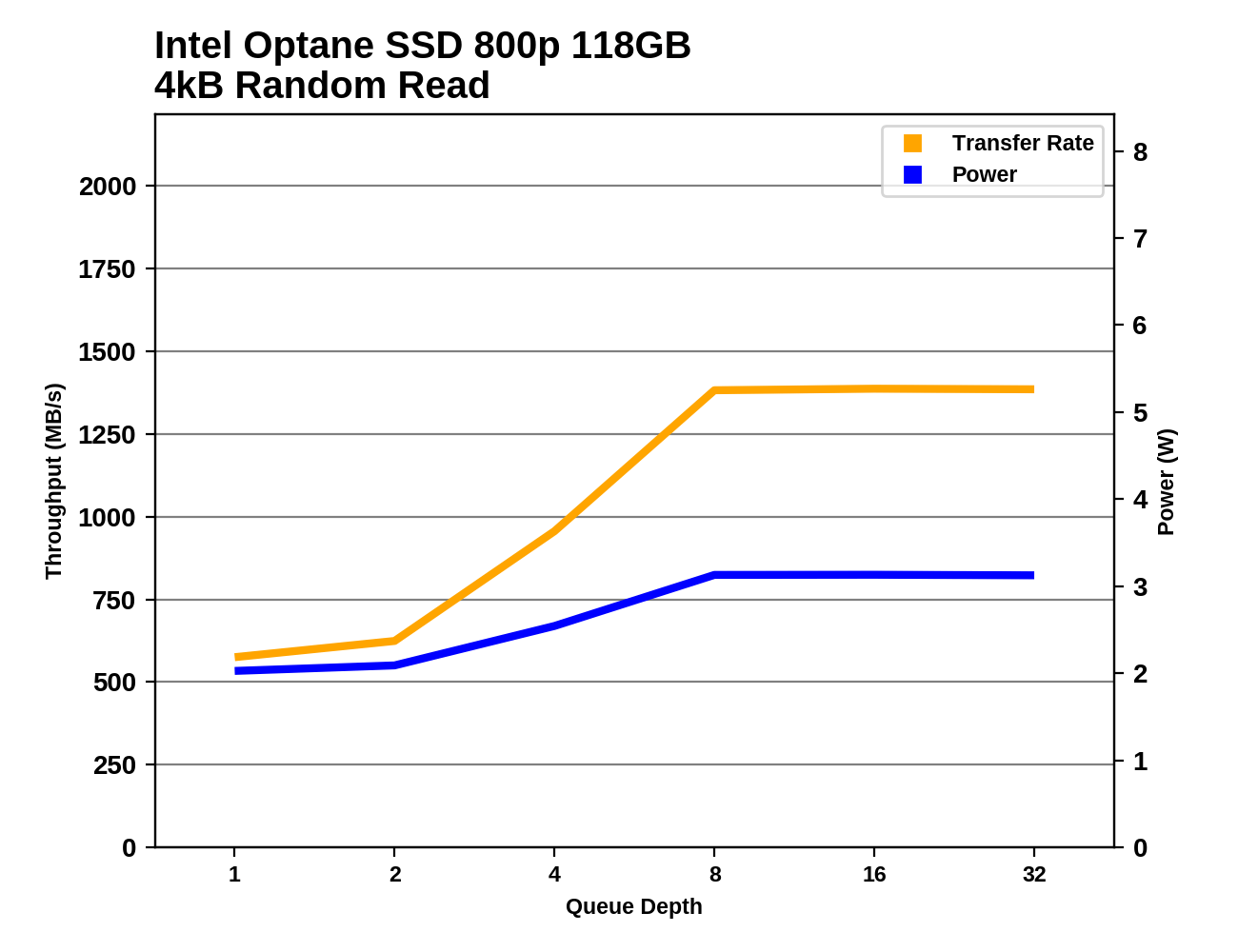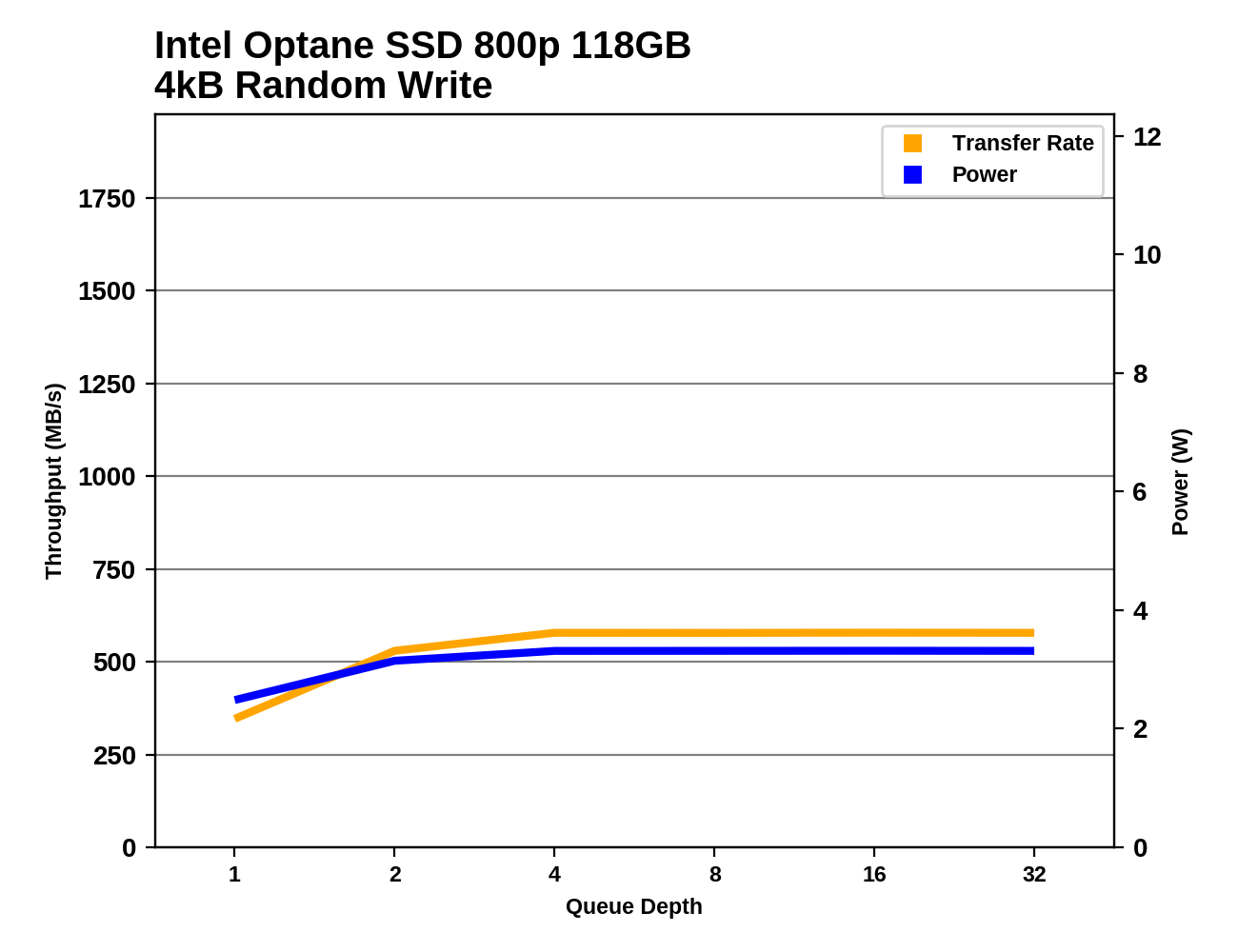The Intel Optane SSD 800p (58GB & 118GB) Review: Almost The Right Size
by Billy Tallis on March 8, 2018 5:15 PM ESTRandom Read Performance
Our first test of random read performance uses very short bursts of operations issued one at a time with no queuing. The drives are given enough idle time between bursts to yield an overall duty cycle of 20%, so thermal throttling is impossible. Each burst consists of a total of 32MB of 4kB random reads, from a 16GB span of the disk. The total data read is 1GB.

Like the Optane Memory M.2, the Optane SSD 800p has extremely high random read performance even at QD1. The M.2 drives even have a substantial lead over the much larger and more power-hungry 900p and its enterprise counterpart P4800X. Even the best flash-based SSDs are almost an order of magnitude slower.
Our sustained random read performance is similar to the random read test from our 2015 test suite: queue depths from 1 to 32 are tested, and the average performance and power efficiency across QD1, QD2 and QD4 are reported as the primary scores. Each queue depth is tested for one minute or 32GB of data transferred, whichever is shorter. After each queue depth is tested, the drive is given up to one minute to cool off so that the higher queue depths are unlikely to be affected by accumulated heat build-up. The individual read operations are again 4kB, and cover a 64GB span of the drive.

The Optane SSDs continue to dominate on the longer random read test, though the addition of higher queue depths allows the 900p to pull ahead of the 800p.

With extremely high performance but lacking the high power draw of the enterprise-class 900p, the Optane SSD 800p is by far the most power efficient at performing random reads.
 |
|||||||||
The Optane SSD 800p starts out in the lead at QD1, but its performance is overtaken by the 900p at all higher queue depths. The flash-based SSDs have power consumption that is comparable to the 800p, but even at QD32 Samsung's 960 PRO hasn't caught up to the 800p's random read performance.
Random Write Performance
Our test of random write burst performance is structured similarly to the random read burst test, but each burst is only 4MB and the total test length is 128MB. The 4kB random write operations are distributed over a 16GB span of the drive, and the operations are issued one at a time with no queuing.

Flash-based SSDs can cache and combine write operations, so they are able to offer random write performance close to that of the Optane SSDs, which do not perform any significant caching. Where the 32GB Optane Memory offered relatively poor burst random write performance, the 800p is at least as fast as the best flash-based SSDs.
As with the sustained random read test, our sustained 4kB random write test runs for up to one minute or 32GB per queue depth, covering a 64GB span of the drive and giving the drive up to 1 minute of idle time between queue depths to allow for write caches to be flushed and for the drive to cool down.

When higher queue depths come into play, the write caching ability of Samsung's high-end NVMe SSDs allows them to exceed the Optane SSD 800p's random write speed, though the 900p still holds on to the lead. The 800p's improvement over the Optane Memory is even more apparent with this longer test.

The power efficiency of the 800p during random writes is pretty good, though Samsung's top drives are better still. The Optane Memory lags behind on account of its poor performance, and the 900p ranks below that because it draws so much power in the process of delivering top performance.
 |
|||||||||
The Samsung 960 PRO and the Intel Optane SSD 900p show off at high queue depths thanks to the high channel counts of their controllers. The Optane SSD 800p doesn't have much room for performance to scale beyond QD2.










116 Comments
View All Comments
name99 - Friday, March 9, 2018 - link
Not QUITE true.Apple has done it (IMHO very successfully) in part because
- they understand something of the data patterns and
- already had tech in the file system to move hot data (hot file system data AND hot files) to the fastest part of the medium and
- they were willing to include ENOUGH flash (128GB) and fast flash; they didn't cheap out.
But yeah, the solutions sold by Seagate were not (in my experience) very impressive, especially considering the ridiculous premium Seagate charged for them.
What you CAN do on Apple systems (and I have done, very successfully, multiple times) is to fuse external SSDs with other drives (either other external or an internal HD) and this behaves just like a native fusion drive, you can even boot off it. This means you can retrofit fusion even to old macs (eg I have a 2007 iMac running a fusion system based on an SSD in an external FW-800 enclosure, fused with the internal 320GB drive).
zepi - Friday, March 9, 2018 - link
Sounds like Apple Fusion drive. Very difficult to do well on drive-level, much easier to do well with some OS support and filesystem level.Afaik people have been relatively happy with their Fusion drives, though personally I find them horribly expensive. Then again, that applies to all Apple storage options, they always feel insanely expensive.
PeachNCream - Friday, March 9, 2018 - link
Optane performance is good in some ways and disappointing in others. I'd like to see the technology improve since NAND endurance is a problem that warrants a solution. Maybe Optane isn't that solution.Reflex - Friday, March 9, 2018 - link
Optane basically is a variation of Phase-Change Memory. It's been around a long time, but Micron/Intel have finally managed to make it in large enough capacities to productize it out of niche markets. There are other contenders for next gen memory &storage, ranging from MRAM (magnetic memory) to ReRAM to racetrack memory (HP has claimed to be on the edge of productizing that for about four years now).I am just happy one finally got out there, an it is in pretty good shape for a first gen product. Hoping this gets others to get serious about bringing alternative storage methods to market soon.
Lolimaster - Saturday, March 10, 2018 - link
At least the 860 EVO and Pro improved endurance a lot for consumer.600TB 860 EVO 1TB
1.2PB 860 Pro 1TB
leexgx - Sunday, March 11, 2018 - link
they can easy do 4x that especially the Pro drive (they was been Really conservative before, mainly so it did not affect the sales of there enterprise drives)heck the 840 Pro did was 2PB before it died suddenly (but it did all that with 0 read errors)
Araemo - Friday, March 9, 2018 - link
Can we get the consistency scatter plots for this drive? Those are an awesome tool to gauge the real world 'feel' of the drive.Billy Tallis - Friday, March 9, 2018 - link
They're an awesome tool to exaggerate the impact of garbage collection pauses on flash-based SSDs. Real-world usage doesn't involve constant writes to a full drive. Those random write consistency graphs often show interesting things about how drives handle GC, but they're a horrible way of ranking real-world performance of SSDs.Zinabas - Saturday, March 10, 2018 - link
As a thought the best case to use these in... would be an AMD Ryzen system with (Fuzedrive) the new software that manages all the drives as one volume. The small capacity would be automanaged by software and would be swapped to fit whatever you're playing at the time.emvonline - Monday, March 12, 2018 - link
so there doesnt seen to be a clear difference in real world applications. its faster with lower latency but does not always show up. could you cleary pick the optane drive vs samsung 960 in a blind test everytime running games and office apps?